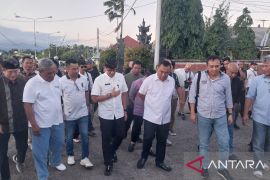The increase was sustained by a high growth of nine percent registered in the health services and social activities sector.
"This was followed by an 8.91 percent growth in the education sector as well as a rise of 6.04 percent in the information and communication sector," Head of the Bali Bureau for Statistics Adi Nugroho stated in Denpasar, Bali, on Monday.
He further noted that each of the three sectors contributed significantly to the islands economic growth.
Meanwhile, the highest expenditure came from household expenses, recorded at 48.30 percent in 2016, indicating a 6.69 percent increase as compared to the previous year.
Balis economy, calculated on the basis of the gross domestic product (GDP), had reached Rp195.38 trillion in 2016 based on the constant price of Rp137.19 trillion and regional GDP recorded at Rp46.52 million.
Nugroho added that looking at the islands GDP economic structure based on the work fields, it is dominated by three main activities comprising food and beverage provision, at 22.82 percent; agriculture, forestry, and fishery, at 14.74 percent; and transportation and storage, at 9.48 percent.
The bureaus head stated that Balis economic growth in the fourth quarter of 2016 was noted at 5.47 percent as compared to the same period in 2015 (year-on-year).
Growth was recorded in almost all sectors except for electricity and gas provision, which experienced a decrease of 1.63 percent.
The highest growth came from the information and communication sector, at 9.15 percent; followed by finance services, at 9.08 percent; and insurance services, at 8.92 percent.
Balis economic structure in the fourth quarter of 2016 was still dominated by three sectors comprising accommodation and food services, with 22.52 percent; agriculture, forestry, and fishery, with 15.07 percent; and transportation and storage, with 9.25 percent.
Compared to the same period in 2015, all three sectors indicated an increase of between three and six percent.
The main growth contributors were agriculture, forestry, and fishery, with 2.92 percent, and construction, with 1.69 percent, Nugroho noted.(*)
Editor: Heru Purwanto
Copyright © ANTARA 2017











